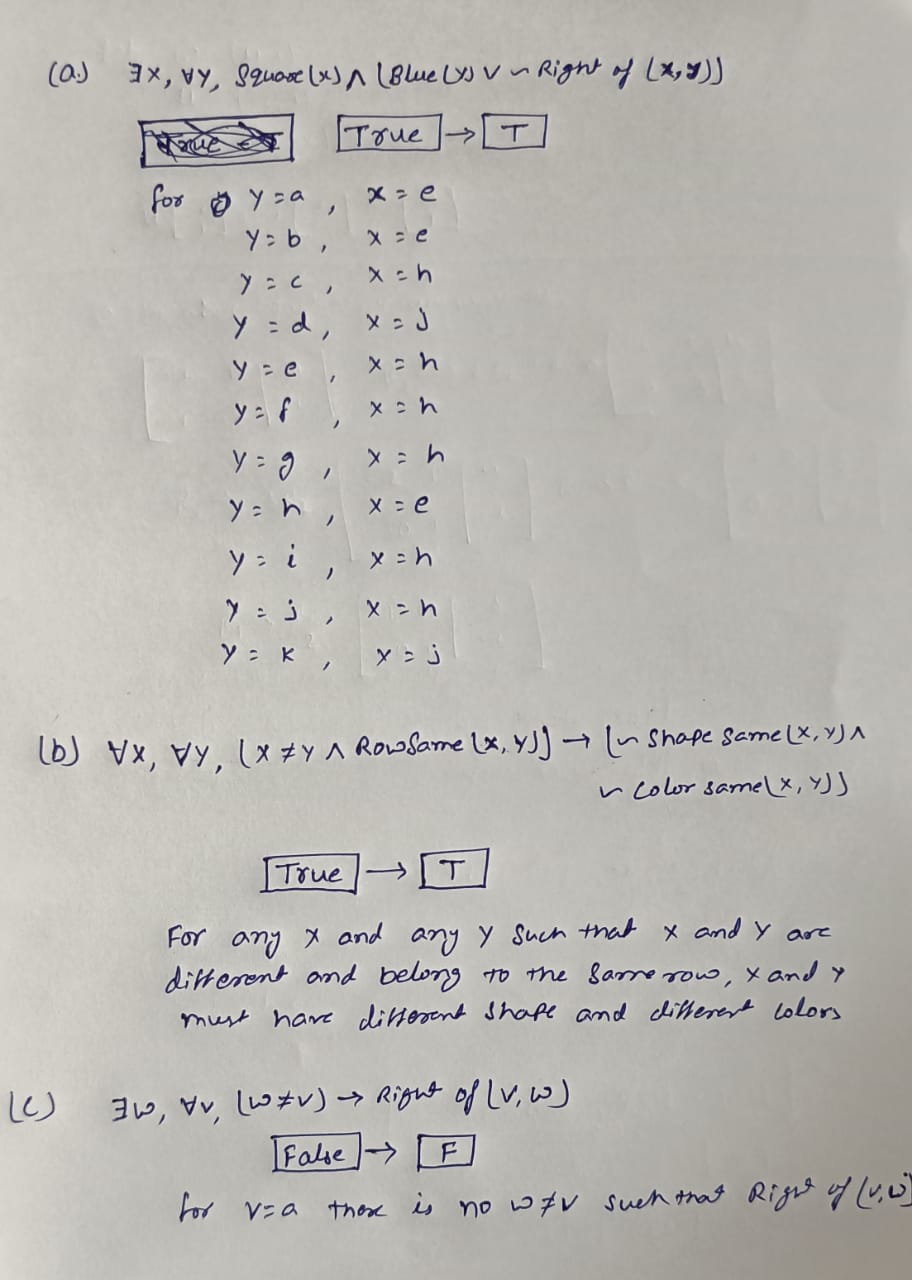Consider the following Tarski world (same world as the previous question, but different questions): AO d. e h Predicates exist as follows: Blue(x) means "x is blue" (and similarly for the other two colors) Triangle(x) means "x is a triangle" (and similarly for the other two shapes) RightOf(x.y) means "x is to the right of y" although possibly in a different row. ShapeSame(x.y) means x is the same shape as y" ColorSame(x,y) means "x is the same color as y RowSame(x.y) means "x is in the same row as y For each of the following statements, say whether the statement is T or F, and then say why. When saying why, you may use the letter c to refer to shape c on the Tarski world, and so on. a) 3 x, Vy, Square(x) ^ (Blue(y) v ~ RightOf(x,y)) Tor F: If False, give a value for y for which no such x exists. If True, give a value for x for which the statement is True: b) Vx, Vy, (x*y a RowSame(x,y) →(~ ShapeSame(x,y) ^ ~ColorSame(x,y)) Tor F: If False, give values for x, y for which the statement is false. If True, describe the meaning of the statement in words (one sentence): c) 3w, Vv, (w- v) → RightOf(v, w) Tor F: If True, give a value of w for which it is true; if False, give a value for v for which there is no such w:
Consider the following Tarski world (same world as the previous question, but different questions): AO d. e h Predicates exist as follows: Blue(x) means "x is blue" (and similarly for the other two colors) Triangle(x) means "x is a triangle" (and similarly for the other two shapes) RightOf(x.y) means "x is to the right of y" although possibly in a different row. ShapeSame(x.y) means x is the same shape as y" ColorSame(x,y) means "x is the same color as y RowSame(x.y) means "x is in the same row as y For each of the following statements, say whether the statement is T or F, and then say why. When saying why, you may use the letter c to refer to shape c on the Tarski world, and so on. a) 3 x, Vy, Square(x) ^ (Blue(y) v ~ RightOf(x,y)) Tor F: If False, give a value for y for which no such x exists. If True, give a value for x for which the statement is True: b) Vx, Vy, (x*y a RowSame(x,y) →(~ ShapeSame(x,y) ^ ~ColorSame(x,y)) Tor F: If False, give values for x, y for which the statement is false. If True, describe the meaning of the statement in words (one sentence): c) 3w, Vv, (w- v) → RightOf(v, w) Tor F: If True, give a value of w for which it is true; if False, give a value for v for which there is no such w:
Calculus: Early Transcendentals
8th Edition
ISBN:9781285741550
Author:James Stewart
Publisher:James Stewart
Chapter1: Functions And Models
Section: Chapter Questions
Problem 1RCC: (a) What is a function? What are its domain and range? (b) What is the graph of a function? (c) How...
Related questions
Question

Transcribed Image Text:Consider the following Tarski world (same world as the previous question, but different questions):
A
b
a
h
j
k
Predicates exist as follows:
Blue(x) means "x is blue" (and similarly for the other two colors)
Triangle(x) means "x is a triangle" (and similarly for the other two shapes)
RightOf(x,y) means "x is to the right of y" although possibly in a different row.
ShapeSame(x,y) means "x is the same shape as y"
ColorSame(x,y) means "x is the same color as y"
RowSame(x,y) means "x is in the same row as y"
For each of the following statements, say whether the statement is T or F, and then say why. When saying why, you may use the letter c to refer to shape c on the Tarski world, and so on.
a) 3 x, Vy, Square(x) ^ (Blue(y) v ~ RightOf(x,y))
Tor F:
If False, give a value for y for which no such x exists. If True, give a value for x for which the statement is True:
b) Vx, Vy, (xy ^ RowSame(x,y)) → (~ Shape Same(x,y) A ~ ColorSame(x,y))
T or F:
If False, give values for x, y for which the statement is false. If True, describe the meaning of the statement in words (one sentence):
c) 3w, Vv, (w # v) → RightOf (v, w)
Tor F:
If True, give a value of w for which it is true; if False, give a value for v for which there is no such w:
Expert Solution
Step 1

Trending now
This is a popular solution!
Step by step
Solved in 2 steps with 1 images

Recommended textbooks for you

Calculus: Early Transcendentals
Calculus
ISBN:
9781285741550
Author:
James Stewart
Publisher:
Cengage Learning

Thomas' Calculus (14th Edition)
Calculus
ISBN:
9780134438986
Author:
Joel R. Hass, Christopher E. Heil, Maurice D. Weir
Publisher:
PEARSON

Calculus: Early Transcendentals (3rd Edition)
Calculus
ISBN:
9780134763644
Author:
William L. Briggs, Lyle Cochran, Bernard Gillett, Eric Schulz
Publisher:
PEARSON

Calculus: Early Transcendentals
Calculus
ISBN:
9781285741550
Author:
James Stewart
Publisher:
Cengage Learning

Thomas' Calculus (14th Edition)
Calculus
ISBN:
9780134438986
Author:
Joel R. Hass, Christopher E. Heil, Maurice D. Weir
Publisher:
PEARSON

Calculus: Early Transcendentals (3rd Edition)
Calculus
ISBN:
9780134763644
Author:
William L. Briggs, Lyle Cochran, Bernard Gillett, Eric Schulz
Publisher:
PEARSON

Calculus: Early Transcendentals
Calculus
ISBN:
9781319050740
Author:
Jon Rogawski, Colin Adams, Robert Franzosa
Publisher:
W. H. Freeman


Calculus: Early Transcendental Functions
Calculus
ISBN:
9781337552516
Author:
Ron Larson, Bruce H. Edwards
Publisher:
Cengage Learning